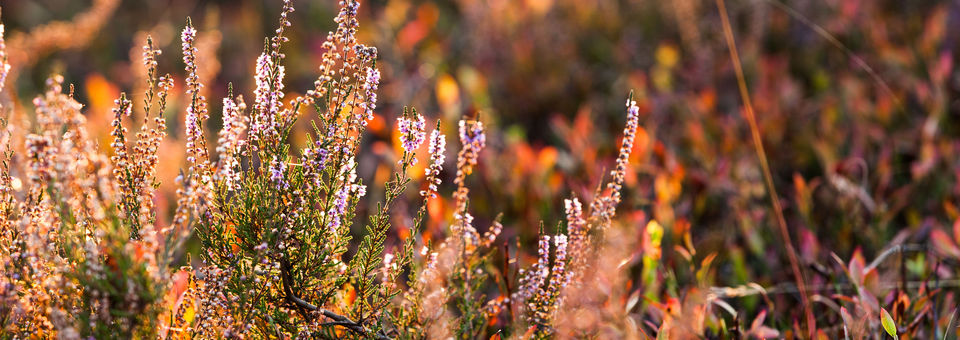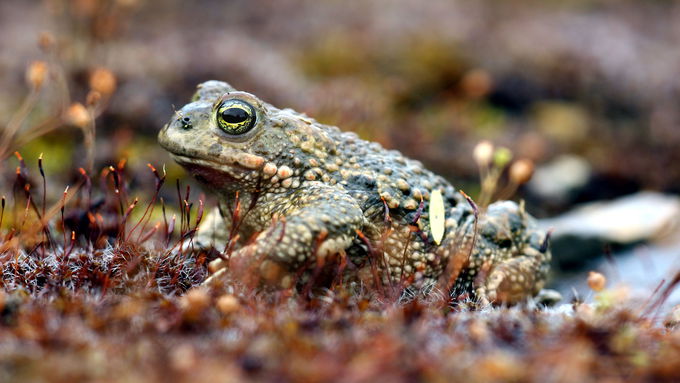Kreuzkröte/Natterjack Toad (Bufo calamita) © Lennart Hudel (https://commons.wikimedia.org/wiki/File:Kreuzkröte_(Epidalea_calamita),_NSG_Grainberg-Kalbenstein,_Bayern.jpg), „Kreuzkröte (Epidalea calamita), NSG Grainberg-Kalbenstein, Bayern“, https://creativecommons.org/licenses/by-sa/4.0/legalco
download picturemain content
Protected Species
BUFO CALAMITA (1202)
Natterjack Toad
With a body length of four to eight centimetres, the Natterjack Toad is the smallest native true toad species. It is to be distinguished well from other toads by means of the characteristic yellow longitudinal line on the back, which already appears with the formation of the extremities in the larval stage, as well as its mouse-like locomotion. The body colour on the warty top side varies between olive and brownish shades. The white to dark grey coloured belly has an individual pattern with dark spots. The larvae are also smaller than those of other amphibian species; the metamorphosis already occurs at a body length of about 15 millimetres. The mating calls of the Natterjack Toad are a series of calls from a metallic-sounding "ärr ... ärr ... ärr" which can be heard in windless nights up to two kilometres.
Habitat and biology
The Natterjack Toad is a pioneer species that colonizes dry, warm terrestrial habitats with partial or sparse vegetation and extremely loose soil. Originally, the floodplains on rivers, which were constantly changing due to the dynamics of floods, played a significant role as a primary habitat. Today, such conditions are found almost exclusively in secondary habitats such as excavation or military training sites. Open embankments and slopes, where the animals can bury themselves during the day and also during the winter months, are particularly important. For reproduction, the Natterjack Toad requires shallow ponds and puddles of a temporary nature which are exposed to sunlight and therefore heat up quickly. In many cases this may be an accumulation of surface water, to a large extent without any vegetation.
The extended reproduction phase of the Natterjack Toad lasts from mid-April to mid-August. The males then begin to call at dusk. During this time the females appear only for a few days at the spawning waters. The main spawning season usually begins at the end of April and continues until the beginning of June. During the spawning phase, the female lays an egg string which is one to two metres long and contains 1,000 to 9,000 eggs at the bottom of the water body. Depending on the time of oviposition and weather conditions, the metamorphosis of the larvae begins after three to twelve weeks. The rapid development up to the young toad represents an important adaptation to the short-lived nature of the spawning grounds. The adult animals migrate to their winter habitats from mid-September to late October. While the young often migrate one to three kilometres, adult animals usually cover a distance of less than 1,000 metres. Generally, Natterjack Toads do not reproduce until their third spring. Their maximum lifespan is seven years in the wild and up to seventeen years in captivity.
Occurrence
In North Rhine-Westphalia, the Natterjack Toad is considered "Vulnerable" (VU). The main distribution area of the species is in the lowlands of the Rhineland and in the Ruhr area. The threats for the species increase where only a few secondary habitats are available. Therefore, the species is "Endangered" in the Westphalian Basin and in the highlands.
In the Red List of Lower Saxony (2013), the Natterjack Toad is classified as "Endangered" (EN). In the sandy geest and lowland areas of Lower Saxony the Natterjack Toad is distributed semi-frequently. In the east, especially in the Lüneburg Heath, in the Wendland with the Middle Elbe Plain and in the Weser-Aller Plains and Geest, the species is slightly more common than in the west. In the natural regions "East Frisian Geest" and northern "Stade Geest" there are only isolated single occurrences, while in the "Ems-Hunte-Geest" probably also mapping gaps exist.
Since Germany owns about 10 to 30 percent of the world-wide occurrence of the Natterjack Toad and lies in the areal centre, there is a high responsibility for the global conservation of this species.
Threats
Emerging spawning waters, which are naturally very short-lived, are largely absent today, mainly because natural processes for their development are prevented, for example by regulation of waterways and subsequent use. There is also a significant lack of open lean biotopes and ruderal areas with natural mesotrophic ponds as a result of intensive management and comprehensive eutrophication as well as the removal of hedges and fringe biotopes. The loss of waters of early succession stages (pioneer waterbodies) also poses a threat. Furthermore, the toads are imperilled both in their summer and winter habitats by intensive tillage associated with agriculture. Other threatening factors are the loss or degradation of spawning waters due to succession or a lack of maintenance action following abandonment, the expansion of road networks, intensive recreational use and increasing isolation of populations.
Types of action
Basic actions for improving the conservation status of the species with regard to existing occurrences in excavation sites include agreements for the protection of spawning waters and water management in the spawning grounds. There should be a regular new creation of temporary or permanent small waterbodies (up to 50 square metres) exposed to sunlight and with shallow water zones. Regular maintenance, e.g. the manual removal of emerging reeds and bulrushes or water plants during the vegetation period is beneficial to the species. Mechanical work should only be conducted during the winter months. Encroaching woodland that casts a shadow should also be removed on a regular basis. To optimise the terrestrial habitat of the Natterjack Toad, the topsoil including the vegetation cover should be stripped or the area around the ponds should be mown at intervals of approximately five years. Extensive grazing is also a suitable means of keeping the habitat open. The use of fertilizers in the terrestrial habitat should be avoided. In the immediate vicinity (preferably three kilometres) around the spawning waters soil compaction by rolling and deep ploughing should also be omitted. In cleared landscapes, small structures or buffer strips to arable landscape must be maintained for possible use as a diurnal hiding place or hibernation site. Linear, spatial-functional biotope network structures have to be maintained as stepping stone biotopes. The distance between the waterbodies should not exceed 2,000 to 3,000 metres.
Actions within phase 1 of the LIFE IP
In the first phase of the project, one measure in North Rhine-Westphalia will focus on improving the conservation status of the Natterjack Toad. In the Dellbrück Heath new spawning waters will be created to stabilise the population at this location.
In Lower Saxony, twelve actions or action packages to improve the conservation status of the Natterjack Toad will be implemented in the first phase of the project. This includes the (initial) restoration of (partial) habitats through desludging, removal of seedlings or reeds as well as the new creation of ponds suitable for the species. In one case, the creation of an extended habitat network system between two subpopulations of the species is planned.
Related Topics
additional information
Further Links
- Species profile „Natterjack Toad“ – State Agency for Nature, Environment and Consumer Protection (LANUV NRW) (in German) (external link opens in a new window)
- Implementation notes for the protection of the Natterjack Toad – Lower Saxony Water Management, Coastal Defence and Nature Conservation Agency (NLWKN) (in German) (external link opens in a new window)
- Species profile „Natterjack Toad“ – German Federal Agency for Nature Conservation (BfN) (in German) (external link opens in a new window)
- German Prioritised Action Frameworks (PAF): Yellow-spotted Whiteface, page 216 – German Federal Agency for Nature Conservation (BfN) (in German) (external link opens in a new window)
- Red Lists and complete species list of Amphibians and Reptiles in Lower Saxony and Bremen (NLWKN) (in German) (external link opens in a new window)




